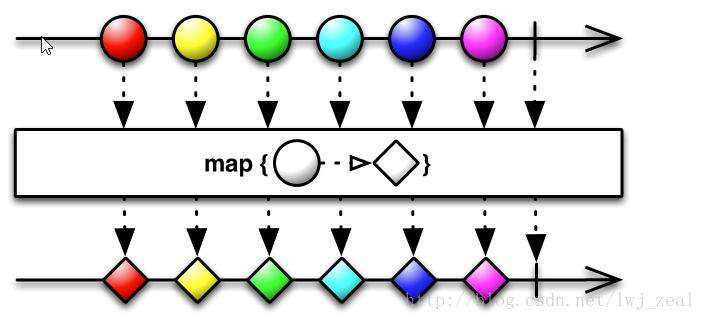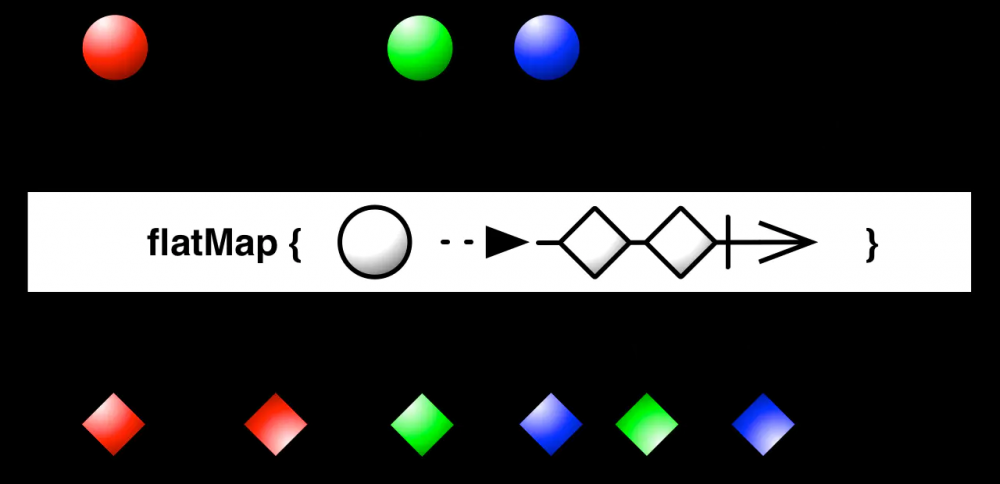RxJava的部分变换操作符源码分析
对Observable发射的 每一项数据应用一个函 数,执行变换操作,如下图。

map操作符对原始Observable发射的的 每一项数据应用一个你选择的函数 ,然后返回一个发射这些结果的Observable。
RxJava将 这个操作符实现为map函数 ,这个操作符默认 不再任何特定的调度器 上执行。
(二)示例
public void mapTest(){
Observable.just("HELLO")
.map(new Function<String, String>() {
@Override
public String apply(String s) throws Exception {
return s.toLowerCase();
}
})
.map(new Function<String, String>() {
@Override
public String apply(String s) throws Exception {
return s + " world";
}
})
.subscribe(new Consumer<String>() {
@Override
public void accept(String s) throws Exception {
System.out.println(s);
}
});
}
复制代码
输出结果:
hello world 复制代码
(三)源码分析
1.调用map()方法
/**
* Returns an Observable that applies a specified function to each item emitted by the source ObservableSource and
* emits the results of these function applications.
*
* @param <R> the output type
* @param mapper
* a function to apply to each item emitted by the ObservableSource
* @return an Observable that emits the items from the source ObservableSource, transformed by the specified
* function
*/
@CheckReturnValue
@SchedulerSupport(SchedulerSupport.NONE)
public final <R> Observable<R> map(Function<? super T, ? extends R> mapper) {
ObjectHelper.requireNonNull(mapper, "mapper is null");
return RxJavaPlugins.onAssembly(new ObservableMap<T, R>(this, mapper));
}
复制代码
2.底层在调用ObservableMap类
将自定义的Function对象赋值给成员变量:function. 该类中同样有个重写的subscribeActual()方法, 在
@Override
public void subscribeActual(Observer<? super U> t) {
source.subscribe(new MapObserver<T, U>(t, function));
}
复制代码
后续调用subscribe()时,其会先调用Observable类中的subscribe()方法
/**
* Subscribes to an ObservableSource and provides a callback to handle the items it emits.
*
* @param onNext
* the {@code Consumer<T>} you have designed to accept emissions from the ObservableSource
* @return a {@link Disposable} reference with which the caller can stop receiving items before
* the ObservableSource has finished sending them
* @throws NullPointerException
* if {@code onNext} is null
*/
@CheckReturnValue
@SchedulerSupport(SchedulerSupport.NONE)
public final Disposable subscribe(Consumer<? super T> onNext) {
return subscribe(onNext, Functions.ON_ERROR_MISSING, Functions.EMPTY_ACTION, Functions.emptyConsumer());
}
复制代码
subscribe(onNext, Functions.ON_ERROR_MISSING, Functions.EMPTY_ACTION, Functions.emptyConsumer()) 该方法会调用Observable同类中的重载的方法:subscribe()
public final Disposable subscribe(Consumer<? super T> onNext, Consumer<? super Throwable> onError,
Action onComplete, Consumer<? super Disposable> onSubscribe) {
ObjectHelper.requireNonNull(onNext, "onNext is null");
ObjectHelper.requireNonNull(onError, "onError is null");
ObjectHelper.requireNonNull(onComplete, "onComplete is null");
ObjectHelper.requireNonNull(onSubscribe, "onSubscribe is null");
LambdaObserver<T> ls = new LambdaObserver<T>(onNext, onError, onComplete, onSubscribe);
// 核心方法
subscribe(ls);
return ls;
}
复制代码
该方法又会调用同类中重载的subscribe()方法
@SchedulerSupport(SchedulerSupport.NONE)
@Override
public final void subscribe(Observer<? super T> observer) {
ObjectHelper.requireNonNull(observer, "observer is null");
try {
observer = RxJavaPlugins.onSubscribe(this, observer);
ObjectHelper.requireNonNull(observer, "Plugin returned null Observer");
// 核心方法,继承Observable的类都须该方法
subscribeActual(observer);
} catch (NullPointerException e) { // NOPMD
throw e;
} catch (Throwable e) {
Exceptions.throwIfFatal(e);
// can't call onError because no way to know if a Disposable has been set or not
// can't call onSubscribe because the call might have set a Subscription already
RxJavaPlugins.onError(e);
NullPointerException npe = new NullPointerException("Actually not, but can't throw other exceptions due to RS");
npe.initCause(e);
throw npe;
}
}
复制代码
此时就会调用 ObservableMap 类中的 subscribeActual() 方法实现,
该方法又会调用上述方法,不过此时subscribeActual()方法是ObservableJust类中的方法
@Override
protected void subscribeActual(Observer<? super T> s) {
ScalarDisposable<T> sd = new ScalarDisposable<T>(s, value);
s.onSubscribe(sd);
sd.run();
}
复制代码
该方法就会使用s.onSubscribe()来BasicFuseableObserver类中的OnSubscribe()方法
// final: fixed protocol steps to support fuseable and non-fuseable upstream
@SuppressWarnings("unchecked")
@Override
public final void onSubscribe(Disposable s) {
if (DisposableHelper.validate(this.s, s)) {
this.s = s;
if (s instanceof QueueDisposable) {
this.qs = (QueueDisposable<T>)s;
}
if (beforeDownstream()) {
//对应的代码
actual.onSubscribe(this);
afterDownstream();
}
}
}
复制代码
进过多次的调用,最终就会调用我们再主方法中重写的accept()方法,输出对应的结果。
二.flatmap操作符
(一)定义
flatMap将一个发射数据的Observable变换为多个Observable,然后将它们发射的数据 合并放进一个单独的Observable ,如图2:

flapMap操作符使用一个指定的函数对原始Observable发射的每一项数据执行变换操作,这个函数返回一个本身也发射数据的Observable,然后flatMap合并这些Observables发射的数据,最后将合并后的结果当作它自己的数据序列发射。
(二)示例
数据类
public class User {
public String userName;
public List<Address> addresses;
public static class Address {
public String street;
public String city;
}
}
复制代码
public void flatMapTest() {
User user = new User();
user.userName = "tony";
user.addresses = new ArrayList<>();
User.Address address1 = new User.Address();
address1.street = "ren ming road";
address1.city = "Su zhou";
user.addresses.add(address1);
User.Address address2 = new User.Address();
address2.street = "dong wu bei road";
address2.city = "Su zhou";
user.addresses.add(address2);
Observable.just(user)
.flatMap(new Function<User, ObservableSource<User.Address>>() {
@Override
public ObservableSource<User.Address> apply(User user) throws Exception {
return Observable.fromIterable(user.addresses);
}
})
.subscribe(new Consumer<User.Address>() {
@Override
public void accept(User.Address address) throws Exception {
System.out.println(address.street);
}
});
}
复制代码
输出结果:
ren ming road dong wu bei road 复制代码
(三) 源码分析
1.flatMap()
flatMap()底层会调用有多个重载的方法,最终会调用如下方法:
/**
* Returns an Observable that emits items based on applying a function that you supply to each item emitted
* by the source ObservableSource, where that function returns an ObservableSource, and then merging those resulting
* ObservableSources and emitting the results of this merger, while limiting the maximum number of concurrent
* subscriptions to these ObservableSources.
*
* @param <R> the value type of the inner ObservableSources and the output type
* @param mapper
* a function that, when applied to an item emitted by the source ObservableSource, returns an
* ObservableSource
* @param maxConcurrency
* the maximum number of ObservableSources that may be subscribed to concurrently
* @param delayErrors
* if true, exceptions from the current Observable and all inner ObservableSources are delayed until all of them terminate
* if false, the first one signalling an exception will terminate the whole sequence immediately
* @param bufferSize
* the number of elements to prefetch from each inner ObservableSource
* @return an Observable that emits the result of applying the transformation function to each item emitted
* by the source ObservableSource and merging the results of the ObservableSources obtained from this
* transformation
*/
@CheckReturnValue
@SchedulerSupport(SchedulerSupport.NONE)
public final <R> Observable<R> flatMap(Function<? super T, ? extends ObservableSource<? extends R>> mapper,
boolean delayErrors, int maxConcurrency, int bufferSize) {
ObjectHelper.requireNonNull(mapper, "mapper is null");
ObjectHelper.verifyPositive(maxConcurrency, "maxConcurrency");
ObjectHelper.verifyPositive(bufferSize, "bufferSize");
if (this instanceof ScalarCallable) {
@SuppressWarnings("unchecked")
T v = ((ScalarCallable<T>)this).call();
if (v == null) {
return empty();
}
return ObservableScalarXMap.scalarXMap(v, mapper);
}
return RxJavaPlugins.onAssembly(new ObservableFlatMap<T, R>(this, mapper, delayErrors, maxConcurrency, bufferSize));
}
复制代码
而后根据this是否为ScalarCallable类,返回不同的对象:
本示例是该示例,进而调用 ObservableScalarXMap.scalarXMap(v, mapper);
/**
* Maps a scalar value into an Observable and emits its values.
*
* @param <T> the scalar value type
* @param <U> the output value type
* @param value the scalar value to map
* @param mapper the function that gets the scalar value and should return
* an ObservableSource that gets streamed
* @return the new Observable instance
*/
public static <T, U> Observable<U> scalarXMap(T value,
Function<? super T, ? extends ObservableSource<? extends U>> mapper) {
return RxJavaPlugins.onAssembly(new ScalarXMapObservable<T, U>(value, mapper));
}
复制代码
进而创建ScalarXMapObservable对象。
2.subscribe()
该方法也有多个重载方法,最终会调用 subscribe(Consumer<? super T> onNext, Consumer<? super Throwable> onError, Action onComplete, Consumer<? super Disposable> onSubscribe) 并执行其中的**subscribe(ls); 方法 进而再调用 subscribe(Observer<? super T> observer) 并执行其中的 subscribeActual(observer);**方法
进而调用 ObservableScalarXMap 的**subscribeActual(Observer<? super R> s)**方法
@SuppressWarnings("unchecked")
@Override
public void subscribeActual(Observer<? super R> s) {
ObservableSource<? extends R> other;
try {
// 核心代码
// 这儿调用在用户自定义的flatMap方法中自定义apply()方法
other = ObjectHelper.requireNonNull(mapper.apply(value), "The mapper returned a null ObservableSource");
} catch (Throwable e) {
EmptyDisposable.error(e, s);
return;
}
// 此处是判断other的类型,进而执行不同的方法
if (other instanceof Callable) {
R u;
try {
u = ((Callable<R>)other).call();
} catch (Throwable ex) {
Exceptions.throwIfFatal(ex);
EmptyDisposable.error(ex, s);
return;
}
if (u == null) {
EmptyDisposable.complete(s);
return;
}
ScalarDisposable<R> sd = new ScalarDisposable<R>(s, u);
s.onSubscribe(sd);
sd.run();
} else {
// 因为other是Observable类型,因而执行这步
other.subscribe(s);
}
}
}
复制代码
在subscribeActual()调用 mapper.apply(value) 执行 用户自定义的flatMap方法中的apply()方法 。
此时又会调用Observable类的subscribe()方法。
注意此处的subscribe()和上面已经调用的Observable不是同一个对象!!!
再次调用该方法中的subscribeActual()方法,进而调用 ObservableFromIterable 类中的**subscribeActual()**方法:
@Override
public void subscribeActual(Observer<? super T> s) {
Iterator<? extends T> it;
try {
// 此处对source的数据进行依次发送
it = source.iterator();
} catch (Throwable e) {
Exceptions.throwIfFatal(e);
EmptyDisposable.error(e, s);
return;
}
boolean hasNext;
try {
// 判断是否it ------------------------------------------
hasNext = it.hasNext();
} catch (Throwable e) {
Exceptions.throwIfFatal(e);
EmptyDisposable.error(e, s);
return;
}
if (!hasNext) {
EmptyDisposable.complete(s);
return;
}
FromIterableDisposable<T> d = new FromIterableDisposable<T>(s, it);
s.onSubscribe(d);
if (!d.fusionMode) {
d.run();
}
}
复制代码











![[HBLOG]公众号](https://www.liuhaihua.cn/img/qrcode_gzh.jpg)

